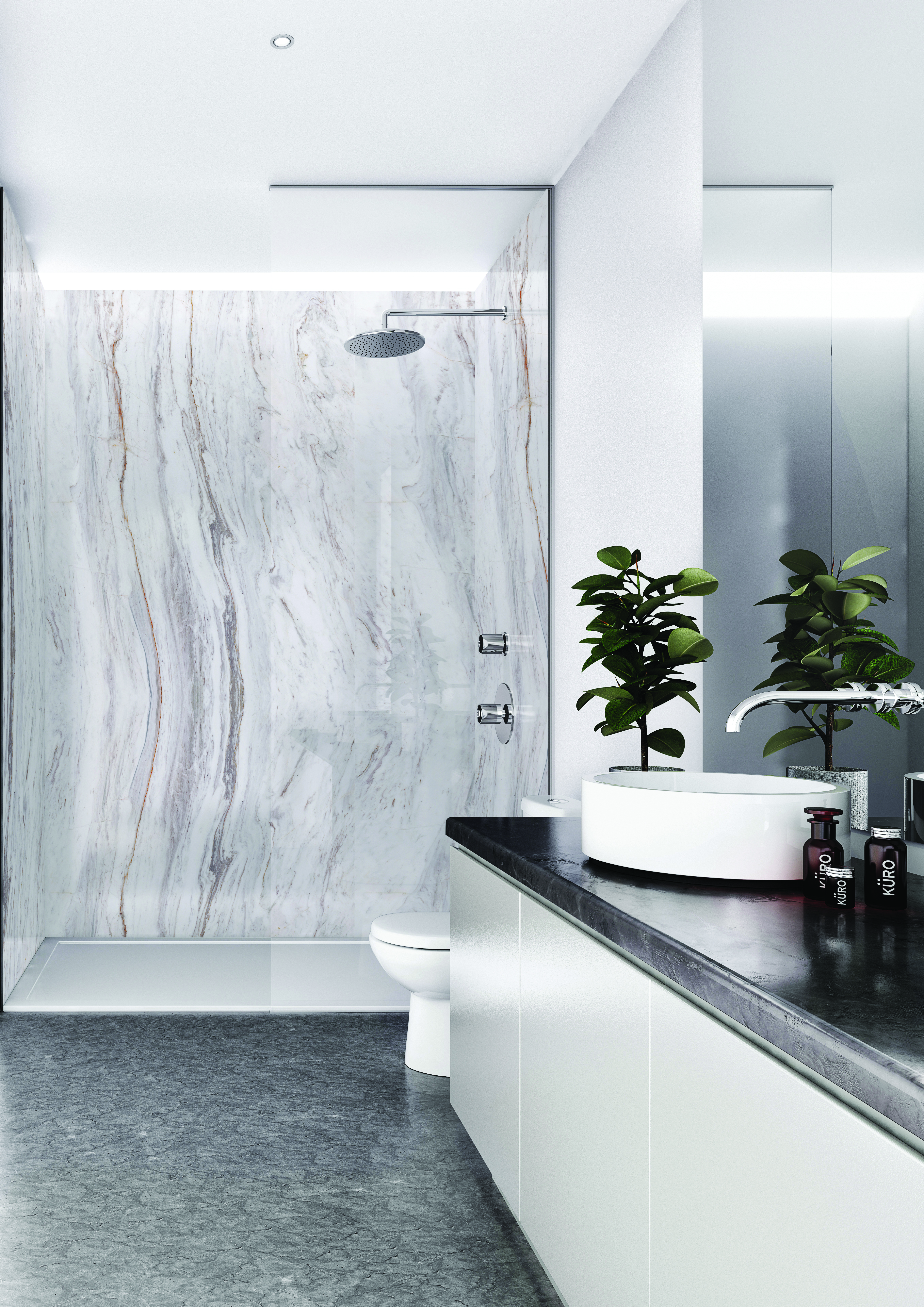Share:
Choosing wall panels for bathrooms ensures a practical and stylish option offering numerous benefits. Wall panels are an increasingly popular choice for homeowners looking to upgrade their bathroom thanks to their easy installation, low maintenance, durability, and versatility.
Generally considered to be much easier and quicker to install than traditional tiles, panels for the bathroom make a popular choice for DIY enthusiasts. So, if you’re looking to upgrade your bathroom but unsure about what materials to use, wall panels could just be the ideal choice for you.
At The Bathroom Showroom, we’re proud to offer some of the most spectacular collections of wall paneling for bathrooms. Here we answer some of the most commonly asked questions about choosing wall panels for this space.

What Are Bathroom Wall Panels Made Of?
Common materials include:
- PVC (Polyvinyl Chloride): Lightweight, 100% waterproof, durable, affordable, and widely available in many designs and finishes. They often have a hollow construction.
- MDF (Medium-Density Fibreboard) Core: These have a solid MDF or plywood core covered with a waterproof laminate. They’re sturdy, durable, and can mimic natural materials like wood or stone very well. They require proper sealing to prevent water ingress.
- Acrylic: Offer a high-gloss, glass-like finish, are lightweight, and waterproof. They’re good for modern aesthetics and bold colours.

Are Bathroom Wall Panels Waterproof?
Yes, the primary benefit of bathroom wall panels is that they’re completely waterproof when installed correctly with the appropriate sealants and trims. This is a significant advantage over tiles, as there's no grout to worry about becoming discoloured, mouldy, or compromised over time.
How Long Do Bathroom Wall Panels Last?
The lifespan of wall panels can vary depending on the material, quality of installation, and maintenance. Generally, you can expect bathroom wall panels to last 10 to 25 years or even more. Some premium timber core panels, for example, come with warranties of up to 30 or 35 years. PVC panels are also very durable but might not last as long as a high-quality MDF core panel.

Can Bathroom Wall Panels Be Installed over Existing Tiles?
Yes, in most cases! This is one of their biggest advantages, as it saves significant time, effort, and mess compared to removing old tiles. The existing tiled surface should be sound (no loose tiles) and clean. Ensure there's enough clearance for fixtures like shower mixer valves and around the bath/shower tray due to the added thickness of the panels.
Can Bathroom Wall Panels Be Used on Ceilings or Floors?
- Ceilings: Many types of PVC cladding are suitable for ceilings, and some designs are specifically made with ceilings in mind. However, larger, heavier shower panels might be unwieldy for ceiling installation.
- Floors: Bathroom wall panels are not recommended for use on floors as they’re not designed for foot traffic and are not slip-resistant. There are specific vinyl bathroom flooring options for this purpose.

Do Bathroom Wall Panels Help with Condensation?
They can help to some extent. Wall panels are often "warm to the touch," which means condensation is less likely to form directly on their surface compared to cold tiles. However, they don’t eliminate condensation entirely. Proper ventilation, such as an extractor fan or dehumidifier, is the only way to effectively control condensation in a bathroom.
How Do I Clean Bathroom Wall Panels?
Cleaning bathroom wall panels is easy! Typically, a micro-fibre cloth with warm water and a non-abrasive mild detergent is sufficient. Avoid harsh chemicals, scouring powders, or abrasive cleaners, as these can damage the panel surface. Wiping them down regularly after use can prevent staining and limescale build-up. For limescale, a 10% solution of citric or acetic acid (white vinegar/lime juice) on a soft cloth can be used, but commercial limescale removers are generally not recommended.

Are Wall Panels Cheaper than Tiles?
It depends. While some very cheap tiles exist, wall panels often work out more cost-effective overall. This is because they’re quicker and easier to install, often allowing for DIY installation, and they can be fitted directly over existing surfaces, avoiding the cost and mess of tile removal and wall preparation. The lack of grouting also saves on materials and labour.
Can I Fit Grab Rails or Shower Seats to Wall Panels?
It’s recommended to fix through the bathroom panels into the solid wall behind for a secure fixing. Always seal around any apertures created for these fittings to maintain the waterproofing.

Should I Install the Shower Tray And/or Bath or Wall Panels First?
It's generally recommended to install the shower tray or bath first. This allows the wall panels to sit on top of the lip of the tray or bath, ensuring that any water running down the panels flows directly into the tray/bath and not behind it. A good quality, flexible sealant should then be applied along the joint between the panels and the fixture.
Shop the Best Waterproof Wall Panels for Bathrooms at the Bathroom Showroom
The Bathroom Showroom offers a fabulous choice of wall panels, which has recently expanded to include the new collection from our very own revered bathroom brand, iflo.
Our lightweight panels come in large sheets, reducing the number of individual pieces you need to install compared to many small tiles. With a tongue and groove interlocking system, iflo bathroom panels can be slotted together seamlessly for a watertight and neat finish. This eliminates the need for messy grout.
Furthermore, with the ability to install wall panels directly over existing tiles or plasterboard, as long as the surface is clean, dry, and flat, iflo wall panels help save significant time and effort.
For further details on our iflo wall panelling collection, take a look at our dedicated brochure.
If you’re looking to buy bathroom wall panels, book an appointment with The Bathroom Showroom. Experts in all things bathrooms, we can help turn your dream bathroom into a reality.